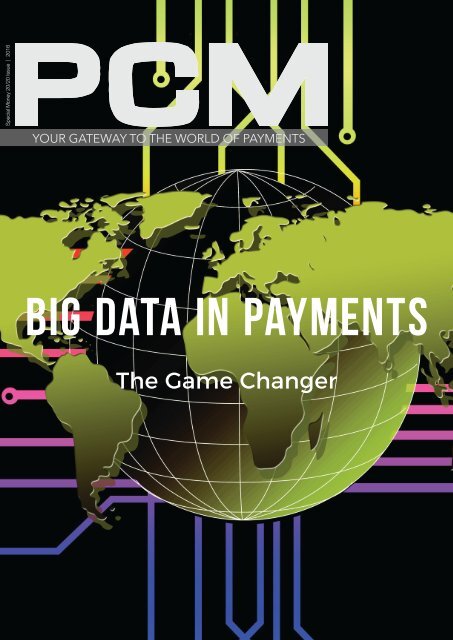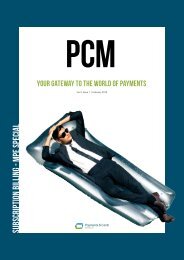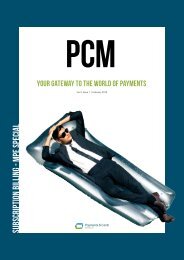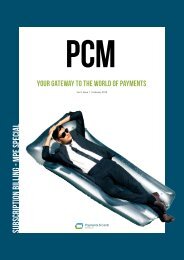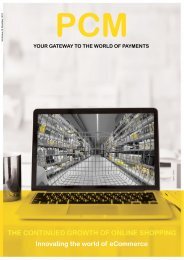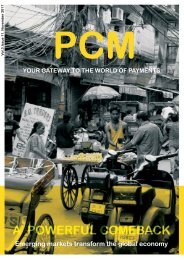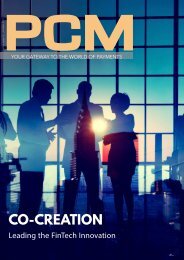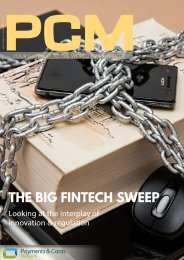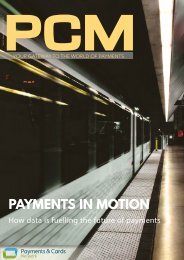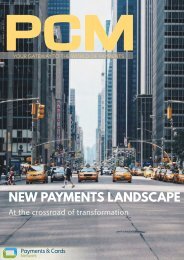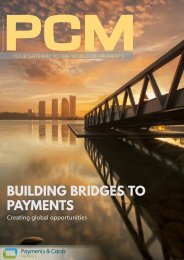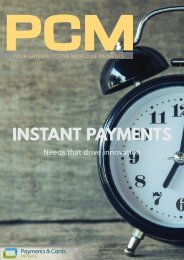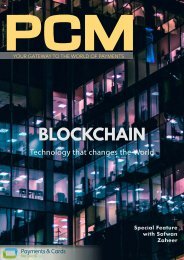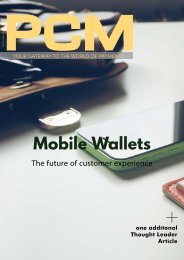Money2020_2016_special
Create successful ePaper yourself
Turn your PDF publications into a flip-book with our unique Google optimized e-Paper software.
Special Money 20/20 Issue | <strong>2016</strong><br />
PCM<br />
YOUR GATEWAY TO THE WORLD OF PAYMENTS<br />
Big Data in Payments<br />
The Game Changer
Welcome to the Money 20/20 <strong>special</strong><br />
October <strong>2016</strong><br />
PCM is published by Payments & Cards<br />
Network - payentsandcardsnetwork.com<br />
© Payments & Cards Network <strong>2016</strong><br />
All rights reserved. The views expressed by<br />
contributors and correspondents are their<br />
own. Reproduction in whole or in part without<br />
written permission is strictly prohibited.<br />
For further information on PCM, please email<br />
amir@paymentsandcardsnetwork.com<br />
“The Data Science sector is multifaceted, with fraud and security<br />
being a large part of it on one side, and the optimisation of payment<br />
processing on the other side”. Nathan Trousdell, Director Strategy<br />
& Corporate Development @Payvision provides an insight into the<br />
role(s) of Data when it comes to the Payments & FinTech space and<br />
how can companies best utilise it to their best interest in our Expert<br />
Interview.<br />
Discover with Edoardo Fiorentini, Risk Manager @Magento “the next big thing” in fi ghting<br />
fraud and reducing risk as part of our Thought Leaders corner. Moreover, Paul Weiss,<br />
Junior Management Consultant, Financial Services @AccentureNL gives an overview<br />
of the next long awaited major project SEPA Instant Payments: plug & p(l)ay. Last but<br />
not least, Isaac Gurary, Co-Founder @NoFraud demonstrates the most effective ways<br />
for SMBs to prevent fraud.<br />
Startup spotlight this issue featuring PayStand. We sat down with Jeremy Almond,<br />
Founder & CEO who gave us a better understanding of PayStand, how it came to live<br />
and what makes it different than other providers in the industry.<br />
In this issue we also accommodate a <strong>special</strong> feature on POUR. POUR is a new initiative<br />
aiming to revolutionise the marketing industry. Nowadays, with ad-blockers and<br />
millions of ads displayed in front of users wherever they go, how do you make your<br />
advertisement stand out? How do you make sure the message is sent the right way? We<br />
sat down together with Jordan Lawrence, Co-Founder & CCO @POUR who gave us a<br />
better understanding of the capabilities of the new app and how this idea came to be.<br />
For any questions, suggestions, or concerns, please address them to the editors:<br />
Amir Abdin - amir@paymentsandcardsnetwork.com<br />
Duc Dang - duc@paymentsandcardsnetwork.com<br />
The Payments & Cards Network team wishes you good reading!
Contents<br />
thoughtleaders<br />
spotlight<br />
4<br />
18<br />
7<br />
STORIES<br />
13<br />
4<br />
SEPA Payments: Plug and P(l)ay<br />
Paul Weiss, Junior Management Consultant, Financial Services<br />
@AccentureNL, dives with us into the new world of instant<br />
payments.<br />
13<br />
Expert Interview: How Data is<br />
transforming Payments<br />
Nathan Trousdell elucidates the increasing importance of data<br />
in the world of payments.<br />
7<br />
The next big thing...<br />
Edoardo Fiorentini, Risk Manager @ Magento, gives us a heads<br />
up on crucial aspects at fraud battlefront of the future.<br />
18<br />
Spotlight: Paystand<br />
We talked to the makers of the payment-as-a-service platform.<br />
10<br />
Effective fraud prevention for SMBs<br />
Isaac Gurary, Co-Founder @NoFraud presents viable fraud<br />
prevention stategies for businesses without a dedicated fraud<br />
& risk management workforce at hand.<br />
21<br />
Special Feature: POURapp<br />
We speak to Jordan Lawrence, Co-Founder & CCO @POUR,<br />
who gave us a deep insight into the capabilities of POUR and<br />
how it is going to revolutionise the marketing industry.
Thought Leaders Corner<br />
by Paul Weiss<br />
SEPA Instant Payments: plug and p(l)ay<br />
SEPA has long dominated the<br />
fi nancial industry, but Europe’s<br />
next major payment project is<br />
just around the corner. Instant<br />
payments are gaining ground, driven<br />
by consumer demand for speed and<br />
convenience. Leading the field here are<br />
the European Central Bank (ECB) and<br />
the European Retail Payments Board<br />
(ERPB), that are driving the development<br />
of the real-time payment system SEPA<br />
Instant Credit Transfer Scheme (SCT Inst<br />
scheme). The creation of the SCT Inst<br />
scheme solution is the first in the world<br />
to be interoperable in a region as large<br />
as SEPA. Crossing borders, both literally<br />
and figuratively.<br />
The key difference between real-time<br />
payments and traditional payment<br />
models is that real-time payments<br />
guarantees instant availability of funds<br />
to the beneficiary of the transaction. In<br />
contrast, real-time authorization of a<br />
transaction on a card is not the same;<br />
the buyer is committed to pay and the<br />
recipient is guaranteed to eventually<br />
receive the funds, but the availability of<br />
funds is not instant.<br />
Instant payments: the new normal<br />
The digitalization of our economy,<br />
with the spread of smartphones and<br />
electronic commerce, entails a general<br />
acceleration of payments. On the one<br />
hand, new technologies lead to changes<br />
in customer habits, allowing for Internet<br />
purchases anywhere and at any time<br />
(including during evening hours,<br />
weekends and holidays). Customers<br />
also expect to pay for and receive<br />
their purchases as fast as possible.<br />
Suppliers, on the other hand, wish to<br />
have the certainty to be paid as soon as<br />
they release their goods and services.<br />
New technologies stimulate innovation<br />
in payments and contribute to the<br />
expectation for instant payments.<br />
It is time for a paradigm shift in payment<br />
processing. SEPA and the first Payments<br />
Services Directive (PSD1) have already<br />
reduced money transfer times (at least<br />
within the European economic area) to<br />
one business day, but that is still a long<br />
way from real time. Instant payments<br />
are set to change that. Instead of being<br />
performed once a day, payments are<br />
performed in real time.<br />
Instant payments, and specifically a pan<br />
European solution, will put tremendous<br />
pressure on traditional card volumes,<br />
which were in essence the only near real<br />
time transaction available in the market<br />
for a long time. Also, the impact of<br />
instant payments shouldn’t be looked at<br />
in isolation. Open API banking – pushed<br />
by PSD2, growth of e/m-commerce in EU<br />
and smartphone, internet penetration –<br />
will provide a big thrust to the uptake of<br />
instant payments in the market.<br />
Anytime, anywhere and any channel<br />
in Europe<br />
The time has never been better to adhere<br />
to an effective euro instant payment<br />
scheme as several European Union<br />
countries at the forefront of payment<br />
technologies have already launched their<br />
own solutions. Examples include Spain,<br />
the Netherlands, Germany and Belgium<br />
– which is not surprising given that<br />
approximately 95% of payments in such<br />
countries are purely domestic. However,<br />
setting up parallel systems does not<br />
necessarily appear to be the most<br />
efficient way forward and is somewhat in<br />
contradiction to the achievements made<br />
through the Single Euro Payments Area.<br />
A pan-European, interoperable scheme<br />
will avoid fragmentation and encourage<br />
the harmonization of euro payments<br />
across the continent – a harmony that<br />
the European PSP community has been<br />
working hard and successfully to instill<br />
in recent years.
Thought Leaders Corner<br />
The ERPB has invited the European<br />
Payments Council (EPC) 1 to create a pan-<br />
European instant payment solution for<br />
all payment service providers in Europe.<br />
EPC says the proposed scheme is the<br />
“fi rst in the world<br />
to be interoperable<br />
in a region as<br />
large as SEPA<br />
and is a response<br />
to European<br />
c u s t o m e r<br />
needs for faster<br />
payments”. It adds<br />
that it will be a<br />
“turning point<br />
in making pan-<br />
European instant<br />
credit transfers in<br />
euro a reality”.<br />
future, banks must shift their entire<br />
product and service mindset towards<br />
instant delivery, both of payments and<br />
also all other banking related offerings.<br />
prominent example among decentralized<br />
peer-to-peer networks using blockchain<br />
technology to transfer funds. Although<br />
still in its infancy, blockchain technology<br />
might revolutionize the financial<br />
industry.<br />
Thus, the question<br />
remains: how viable is<br />
the business model of<br />
the traditional bank?<br />
Banks should not<br />
maintain the status quo<br />
and hope the fintech<br />
storm will pass. Rather,<br />
business models should<br />
be re-designed and<br />
transformed, allowing<br />
banks to ride the fintech<br />
wave.<br />
Real time gets<br />
real<br />
Following the three-month public<br />
consultation on the SCT Inst scheme<br />
(April – July <strong>2016</strong>), the EPC will review all<br />
comments, in close collaboration with<br />
stakeholder representatives. The target<br />
date for the publication of the SCT Inst<br />
scheme is next month. The scheme<br />
would enter into force in November<br />
2017, to leave enough time for scheme<br />
participants to implement the necessary<br />
changes in their organizations. The<br />
short period between the publication<br />
of the scheme and the fi rst SCT Inst<br />
transactions demonstrates the payment<br />
industry’s confidence in PSPs to adapt<br />
well to customers’ needs, and quickly<br />
implement major changes.<br />
Source: Fyer EPC | The SEPA Instant Credit Transfer Scheme in a Nutshell<br />
Banks engaging in<br />
payments services will have to upgrade<br />
or substitute existing infrastructure in<br />
order to offer instant payment services.<br />
Given the low profitability of the banking<br />
sector in the light of the low interest<br />
rate environment, heavy investment<br />
in revamping infrastructure may be<br />
challenging.<br />
At the same time, focusing investment<br />
on a centralized instant payment<br />
services system may not be the right<br />
move as technology continues to evolve.<br />
Blockchain technology, a decentralized<br />
payment network, also offers a way to<br />
pay in real time, without the need of<br />
an intermediary. Bitcoin is the most<br />
Bank’s strategy: Need<br />
for Speed<br />
Establishing an IP capability can be<br />
challenging for banks, requiring a<br />
redesign of internal processes and an<br />
alteration of current batch-payment<br />
operations. Underlying payments<br />
technologies and central infrastructures<br />
also need modernizing. To realize the<br />
opportunities that instant payments<br />
opens up, banks need to take a proactive<br />
and holistic approach to the transition.<br />
This involves four key steps:<br />
1. Formulate the vision and strategy<br />
for real-time payments early, setting<br />
out the vision, strategy and value<br />
proposition for shifting the bank<br />
from a 30-year-old legacy payments<br />
Payments as a threat to banks’<br />
business models<br />
Arguably the most fundamental change<br />
required by the advent of instant<br />
payments is a shift of service mindset<br />
for banks. Real-time payments is a key<br />
component of the everyday bank, which<br />
takes a central role in its customers’<br />
everyday lives. This is because a real-time<br />
payments capability is a vital enabler<br />
for the real-time banking products and<br />
services – instantaneous, always-on,<br />
always-available via any device – that<br />
banks customers are now demanding.<br />
So, to retain and win customers in the
Thought Leaders Corner<br />
model to a 24x7x365 payments<br />
model. The bank can then defi ne<br />
their scope for turning its vision<br />
into reality, including product types,<br />
geographies, channels and clients<br />
2. Take a hard look at the implications<br />
and opportunities around products<br />
and customers, including how<br />
increasing adoption of instant<br />
payments will impact existing<br />
payment types and revenue<br />
streams<br />
3. Revisit platforms and system<br />
components, to pinpoint areas<br />
where significant modernization<br />
is needed to enable real-time<br />
processing and ensure continuous<br />
availability<br />
4. Implement organizational redesign<br />
of the bank’s payments value chain,<br />
ranging from customer service<br />
to fraud operations and intraday<br />
liquidity management<br />
Accenture has created a digital IT<br />
blueprint for the everyday bank,<br />
mapping out how banks worldwide<br />
can leverage digital technologies to<br />
take a central role in their customers’<br />
lives. Instant Payments – the real-time<br />
transfer and availability of funds 24x7 –<br />
is a key element of this blueprint for the<br />
future of banking, enabling financial and<br />
non-financial activities to be undertaken<br />
for customers in real-time at any time of<br />
day or night.<br />
Everyone wants everything instantly!<br />
The market is sending a clear message:<br />
consumers, businesses and regulators<br />
want fast, seamless payment services<br />
that are available all the time,<br />
everywhere, from any device. Instant<br />
payments contribute to more than just<br />
customer satisfaction. Instant payment<br />
solutions allow the development of new<br />
high-value services within and beyond<br />
payments. With challenges across the<br />
board, banks will have their work cut out<br />
for them to keep up with the changing<br />
world of payments in <strong>2016</strong>. It is shaping<br />
up to be a pivotal year for the payments<br />
industry as regulation, new technology<br />
and security issues combine to reshape<br />
the landscape. Financial institutions<br />
need to ensure they capitalize on<br />
opportunities before it is too late.<br />
Paul Weiss<br />
Paul Weiss works within Accenture’s<br />
Management Consulting Practice,<br />
Industry Financial Services, based<br />
out of the Netherlands <strong>special</strong>ized in<br />
payments and digital banking. Paul<br />
has worked with several financial<br />
institutions to assist them in defining<br />
their business and technology strategy<br />
and then playing a role executing and<br />
delivering against that strategy.<br />
Accenture<br />
Accenture is a leading global professional services company, providing a broad range of services<br />
and solutions in strategy, consulting, digital, technology and operations. Accenture has extensive<br />
experience in payments, Everyday Banking, open APIs and digital banking strategies - and can help<br />
organizations to navigate the optimal route along this journey.
Thought Leaders Corner<br />
by Edoardo Fiorentini<br />
I<br />
know that fraudsters don’t sleep. Well,<br />
of course they do, but most likely in<br />
different time zones and we all know<br />
what they do… to us. But what are<br />
they doing when they are not placing<br />
fraudulent orders?<br />
Forget the naïve idea of a guy with a<br />
mask, sitting in his mother’s basement<br />
with dimmed lights. Good fraudsters<br />
are highly educated people who, for one<br />
reason or another, fall into the illegal<br />
practice of attempting online fraud.<br />
These people study, group together and<br />
share lots of information as well as tips<br />
and tricks for their fraudulent schemes.<br />
It is our duty as fraud prevention / risk<br />
management experts to keep tracking<br />
their MO and see how it changes. While<br />
these guys can afford to sleep, we can’t.<br />
And it’s not only because we need to<br />
prevent and manage fraud, it’s also<br />
because a slight increase of chargebacks<br />
won’t cause you a big headache, in the<br />
short run. Exactly this-- In the short<br />
term, you could potentially keep doing<br />
things as you have been doing in the<br />
past. But what will happen tomorrow?<br />
The Next Big Thing...<br />
When fraudsters inevitably attempt<br />
what you hadn’t already thought of, how<br />
fast will you react?<br />
There is no valid answer. Each vertical<br />
and region will behave differently, but<br />
we need to keep studying fraudsters<br />
and finding out what tools are available<br />
now on the market.<br />
So “what is the next big thing?” you<br />
might ask yourself. But you are wrong<br />
to ask! First of all, you should already<br />
know. You should have a roadmap<br />
consisting of business cases that will<br />
justify implementing additional tools<br />
and functions to your order processing<br />
at one point in time or, better, at what<br />
volumes we should start doing X or we<br />
should stop doing Y.<br />
This should be clear to you. If you<br />
don’t have a Machine Learning tool,<br />
when would it make sense for you to<br />
implement it?<br />
Remember that you need to make these<br />
changes before fraud hits you badly.<br />
Doing them after would be like closing<br />
the gates when the horses already left.<br />
I mentioned earlier that your question<br />
was wrong. Of course, I’m trying to<br />
provoke a reaction in you. There<br />
is nothing bad in implementing an<br />
additional API call to external sources<br />
(credit card / email / IP and anything<br />
else that is currently provided on the<br />
market). Actually, in my opinion, you<br />
need these implementations to happen<br />
quite soon.<br />
So “what’s next?” This is the point. What’s<br />
next? Have you asked a fraudster?<br />
Assuming you caught one, I wouldn’t ask<br />
him. By catching him, you immediately<br />
know he’s not the type of fraudster who<br />
could tell you.<br />
Doing your homework by infiltrating<br />
their forums (and shops) would certainly<br />
benefit you, but there’s no doubt that<br />
you will just scratch the surface of the<br />
problem.<br />
When the industry comes up with<br />
something new, you already know that<br />
it will mean your conversion rate may<br />
suffer. Only the headache of having
Thought Leaders Corner<br />
to justify your numbers toward some<br />
screaming account managers or<br />
marketing people is enough to ensure<br />
that you will consider new tools with<br />
higher scrutiny and doubt yourself<br />
before actually hitting the “On” button.<br />
So, what is left to do?<br />
Calm down, I don’t want to scare you.<br />
Well, I did, but just a little bit. Every<br />
fraud manager should always be a little<br />
scared. We manage risk. We know the<br />
consequences of getting hit where we<br />
wouldn’t expect. We know the financial<br />
losses may get us fired. But this fear is<br />
vital to keep us pushing to fine tune our<br />
rules, analyze more data and keep a<br />
safe profile as often as possible.<br />
What you could do is look for smarter<br />
ways of doing your job. And the smarter<br />
ways are actually not only extremely<br />
beneficial for the data, but most of the<br />
time, also cheaper than the current<br />
solution.<br />
There are tons of possible examples.<br />
Let’s start from the end: Chargebacks.<br />
I hope you manage those. Outsourcing<br />
this task could seem like a valid move<br />
initially, but you will lose grip on why<br />
your buyers are spending time filling<br />
out the required paperwork to start a<br />
chargeback. Keeping it all in-house will<br />
soon prove to you that there are some<br />
fraudulent chargebacks that you will<br />
lose 100% of the time.<br />
So, how about sending the complex<br />
chargebacks (or the un-winnable ones)<br />
to an external company?<br />
The same goes for data enrichment<br />
providers: Of course you could send your<br />
whole data to an address verification<br />
provider. Or you could search manually<br />
(only for the outsourced orders) with<br />
lower fees. But what about skipping the<br />
returning good customers completely<br />
(and the returning fraudsters!) and<br />
refraining from sending them to the<br />
manual review population?<br />
But then, there are other tools that<br />
you could actually use for overall<br />
conversion optimization. There is a lot<br />
of talk around behavioral analysis for<br />
risk management, but what about prerisk<br />
or other areas? I mean, you have a<br />
whole marketing department spending<br />
millions to attract visitors and SEO<br />
experts working in a close loop with<br />
Social Networks experts to provide<br />
aimed campaigns. Finally, they manage<br />
to bring new potential customers to<br />
your website, but you don’t analyze and<br />
use this data? Of course, it is a great<br />
idea to track all of this traffic, it is even<br />
better to prepare different scenarios to<br />
facilitate conversion.<br />
Here goes another example: Marketing<br />
spent money to engage with the<br />
existing email database of previously<br />
seen customers. Are they removing the<br />
fraudulent guys you already spotted in<br />
the past or are they sending advertising<br />
emails to them too? And what about the<br />
“returning customer”…? Are you offering<br />
him, as first choice, his previously used<br />
payment sub tender as the preferred<br />
one? Are you using the available<br />
information to enhance and facilitate his<br />
checkout experience? When you detect<br />
that the customer is using a Dutch<br />
keyboard, Dutch IP address, Dutch<br />
operating system… on a non-Dutch<br />
store… would you offer him use of some<br />
Dutch-specific payment method (read:<br />
iDeal)?<br />
But let’s get there gradually:<br />
On most of the store sites where I shop,<br />
I need to select from a drop-down menu<br />
if I’m using an Amex, Visa, Mastercard<br />
or whatever card. Why? Do you really<br />
think you need more than 1 hour of<br />
development to automatically figure out<br />
what card your customer is using (via<br />
the bin digits)?<br />
So here is my take: the next big thing is<br />
not a single “new” item on our list. Maybe<br />
it is a combination of an optimized<br />
Edoardo Fiorentini<br />
Risk Manager at Magento<br />
Edoardo “Edo” Fiorentini is currently the<br />
Risk Manager of Magento Commerce,<br />
co-chair of the Fraud Committee and<br />
European Advisory Board of directors<br />
of the MRC (Merchant Risk Council). He<br />
describes himself to be a passionate risk<br />
professional with years of experience<br />
with CNP transactions. Edo has been<br />
fully dedicated into achieving and<br />
maintaining the difficult balance between<br />
fraud management and conversions in<br />
e-commerce.<br />
series of different tools that will be used<br />
on demand.<br />
Efficiently Using external resources is<br />
no secret at all. In fact, there are many<br />
risk platforms that have the capability<br />
of pinging providers when a set of<br />
conditions is met. This of course reduces<br />
costs and increases the accuracy of the<br />
final scoring (and action) of an order.<br />
But then again, this is not “new” stuff.
Thought Leaders Corner<br />
“Harmonize different tools to improve<br />
efficiency and cut on some costs” …. I<br />
think I’ve heard this before. Even before<br />
the PC master race or the spread of<br />
internet. This won’t be a new invention.<br />
We don’t need to re-invent the wheel.<br />
But we should welcome the genius who<br />
decided to put some rubber around the<br />
rim.<br />
So, what’s the next big thing?<br />
If you reached this point in the article,<br />
you may guess where I’m going: back to<br />
basics.<br />
The next big thing is the human brain.<br />
Human logic. And while multi-billion<br />
dollar companies are heavily investing<br />
into the future, we need to manage risk<br />
today. And the closest thing we have to<br />
the future is a human brain.<br />
Your data/risk analyst people are the<br />
best source of hypotheses, analysis, rule<br />
optimization, external sources checks<br />
and so forth. These are the people you<br />
can talk to. These are the professionals<br />
who will read the news, interface with<br />
peers in the industry, update their<br />
knowledge by attending conferences<br />
and webinars and so on.<br />
Also, a good analyst will be thinking out<br />
of the box with a smart attitude towards<br />
challenges. A machine cannot do this,<br />
yet. A clever professional analyzing your<br />
data could focus on the low hanging fruit<br />
in fixing and optimizing your resources.<br />
She or he will also provide feedback to<br />
the manual reviewers and customer<br />
support agents, while also gathering<br />
back some precious insights on the real<br />
work and having the opportunity to not<br />
only improve the system to save costs<br />
and losses, but also to improve the<br />
overall customer experience during the<br />
journey of a purchase on the web.<br />
Don’t be cheap. Get the best analyst you<br />
can get your hands on and keep them<br />
happy. Give them as much freedom as<br />
possible to experiment, make changes<br />
and develop new tools. Remember, they<br />
are the professional who manages the<br />
imperfect system that prevents fraud on<br />
your store. But they are also the same<br />
professional who will minimize the<br />
insult rate of incorrectly rejected good<br />
customers.<br />
Magento<br />
A powerful and unrivaled commerce platform, Magento Enterprise Edition is designed to empower<br />
merchants to rapidly innovate and deliver engaging experiences to customers across all channels and<br />
devices. The platform delivers rich, out-of-the-box functionality, enterprise performance and scale, and<br />
seamless integrations with third-party solutions to keep you ahead of increasingly complex commerce<br />
operations, and growing customer demands.
Thought Leaders Corner<br />
Effective Fraud Prevention for SMBs<br />
by Isaac Gurary<br />
When most people think of online credit card fraud,<br />
they imagine fraudsters targeting popular websites<br />
such as Tiffany’s, Amazon or Macy’s. While large<br />
businesses are most certainly targets for fraud,<br />
most have sophisticated in-house fraud departments that<br />
exclusively deal with fraud prevention. Those fraud prevention<br />
departments are generally well staffed with experts that have<br />
access to sophisticated fraud detection technology.<br />
When it comes to small to mid-sized businesses, most are not<br />
able to afford to employ such personnel and fraud prevention is<br />
often delegated to customer service reps, warehouse managers<br />
or simply anyone that happens to have a few extra hours that<br />
can manually review certain orders.<br />
The latest LexisNexis True Cost of Fraud Report (<strong>2016</strong>) states that<br />
the average small to mid-sized eCommerce business receives<br />
353 fraud attempts monthly, of which 114 are successful. This<br />
obviously comes at great cost to eCommerce merchants, so<br />
many have implemented basic fraud prevention strategies to<br />
help mitigate this risk.<br />
What are some of these strategies that SMBs are currently using<br />
for fraud prevention?<br />
1. Usage of Gateway Fraud Filters: Most Gateways allow<br />
the eCommerce merchant to set up some basic rules to<br />
block transactions that may be fraudulent. An example of<br />
that is when there is an AVS mismatch they can decline the<br />
transaction. This is generally the first line of defense used<br />
by SMBs and can work decently for businesses that are<br />
not high fraud targets. This is not a great solution for most<br />
eCommerce businesses as the selection of available rules<br />
is pretty sparse and the available rule set capabilities are<br />
not very flexible, leading to a higher rate of false positives<br />
(blocking a legitimate transaction due to overzealous fraud<br />
prevention efforts). The technology utilized is also pretty<br />
basic so the potential to block all fraudulent transactions is<br />
limited as well.<br />
2. Manual Review: Many eCommerce merchants will have<br />
employees that will review purchases over a certain<br />
dollar amount to confirm their legitimacy. Currently, the<br />
average eCommerce merchant manually reviews 26%<br />
of all transactions*. The manual reviews typically involve<br />
using search engines such as Google to find any mentions<br />
of the purchaser’s name or other credentials, tracking<br />
the purchaser’s social media accounts, and using online<br />
maps, often with street views to make a best estimate if<br />
transaction on their website was made by the cardholder.<br />
While this is a definitely improvement for using gateway<br />
filters exclusively and manually reviewing orders does catch<br />
a lot of obvious fraud, there are still quite a few downsides<br />
to this method:<br />
a<br />
The employee(s) doing the manual review would need to be<br />
up to date with all the latest fraud tactics - any knowledge<br />
gap can be very costly.
Thought Leaders Corner<br />
b<br />
Manual review costs money in employee time & error.<br />
c<br />
The fraud prevention resources that are available to<br />
the employees doing the reviews are quite limited and<br />
the methods are unscientific. You will often hear such<br />
employees say how they rely on their “gut feeling”as<br />
opposed to relying on concrete data and statistics.<br />
3. Third party fraud prevention solutions - There are many<br />
firms that offer technological solutions to help mitigate<br />
fraud risk. They generally fall into three categories:<br />
a<br />
b<br />
Scoring model/Scoring & Tool model: These solutions<br />
leverage multiple third party fraud prevention databases<br />
and use the data to provide a risk score, which is the<br />
likelihood that a transaction is fraudulent. Some of those<br />
tools go further and provide tools to create logic on how<br />
to interpret the score. These solutions are a boon to SMBs<br />
as the available resources for fraud detection are greatly<br />
enhanced. However, eCommerce businesses still need<br />
to do a significant amount of manual review for those<br />
transactions that are not obviously legitimate or fraudulent.<br />
Additionally, creating rules can be extremely complex for<br />
an employee that is not a fraud expert. Moreover, if the<br />
employee that built the fraud rules leaves the company,<br />
there is a very long learning curve for the replacement to<br />
get up to date and understand the logic of the rule set.<br />
Many such systems also require an upfront fee in services,<br />
which can be costly for a small merchant.<br />
Fraud Prevention Solutions that offer Insurance on<br />
their decision: These solutions are fairly new to the market<br />
(2-3 years) but have been growing quickly in popularity.<br />
ECommerce merchants send all their transaction data to<br />
the insurance solution and will be provided with a yes/<br />
no response on the transaction’s legitimacy. If the order<br />
that was passed as legitimate ends up resulting in a fraud<br />
chargeback, the insurance company will cover the full cost<br />
of the chargeback. These solutions are ideal for merchants<br />
that do not want to have the responsibility of dealing with<br />
any fraud related tasks. However, this peace of mind comes<br />
at a big cost:<br />
i. These solutions are very pricey and typically cost between<br />
1% - 4% of gross revenues<br />
ii.<br />
iii.<br />
c<br />
Isaac Gurary<br />
Co-founder, NoFraud<br />
As president of MaidenLane Jewelry, Isaac Gurary understood<br />
the challenges his customers were facing battling fraud. With<br />
his partner, he founded NoFraud and successfully built a<br />
solution that fused every fraud prevention technology with<br />
human intelligence to eliminate fraud without erroneously<br />
blocking legitimate transactions.<br />
The contract terms for these solutions are often long and<br />
set up fees can get expensive<br />
The false positive rate(blocking legitimate transactions) rate<br />
is often higher as the company protects itself against paying<br />
out claims.<br />
Hybrid Solution: merging the strengths of the existing<br />
fraud prevention options is a hybrid solution. The solution<br />
charges a fee per transaction (like the tool models) and is<br />
a full service solution (similar to the insurance models) and<br />
works in real time so no fraud expertise is needed from<br />
the eCommerce merchant and no fraud prevention work<br />
is needed on the part of the merchant either. An optional<br />
Chargeback protection is available as well that can be turned<br />
on or off at will without any long term commitment which<br />
can be helpful for those that are risk averse. Affordable and<br />
once set up, friction free, this is a great option for SMBs.<br />
NoFraud is an example of such a solution.<br />
How does an SMB choose the most fitting fraud prevention<br />
solution?<br />
As there are so many options for eCommerce SMBs to mitigate<br />
their fraud risk, what can be helpful is for the merchant to ask<br />
themselves the following questions:
Thought Leaders Corner<br />
1. Does the product I am selling have a high resale value?<br />
Most fraudsters are not after the actual product they steal<br />
and will often will resell the stolen goods for cash. If you<br />
are selling products with a high resale value then you are<br />
a high target. High fraud categories include jewelry, brand<br />
name watches, electronics, auto parts, branded clothing.<br />
However, many businesses that are not in any of those<br />
categories will still find themselves targeted so even a<br />
merchant that sells items with low resale value should still<br />
be aware of the existing risks of fraud.<br />
2. Do I have a past history of fraud? Fraudsters are people<br />
with human motivations. Once a fraudulent order gets<br />
shipped from your website, you are automatically a higher<br />
target as the fraudster realizes that your fraud screening<br />
is not up to par and will keep trying to evade your fraud<br />
prevention efforts. It can often take years before fraudster<br />
gives up on targeting your website.<br />
4. How risk averse am I? What resources do I have<br />
available? For those that want to spend a preset amount<br />
of fraud and/or do not have the resources to build and<br />
maintain a fraud prevention rule set and conduct manual<br />
review, the Insurance model or Chargeback protection<br />
model via the hybrid solution may be the way to go.<br />
Whatever the solution the eCommerce merchant will choose,<br />
fraud prevention is a growing threat to SMBs. Thankfully there<br />
are a plethora of options available to the small and mid-sized<br />
businesses so those that choose a product that is well tailored<br />
to their level of fraud risk/available resources/technological<br />
integration, this threat can be kept under control.<br />
*LexisNexis True Cost of Fraud study 2015<br />
3. What eCommerce platform do I use? While most fraud<br />
prevention solutions can integrate with open source<br />
platforms (ex: Magento) many SMBs choose to have their<br />
websites hosted by eCommerce platforms such as Shopify<br />
or 3D Cart. With hosted platforms the fraud prevention<br />
options are more limited as each fraud prevention solution<br />
needs to build custom integration into the platform.<br />
NoFraud<br />
NoFraud is a full-service solution. AVS/CVV is built-in, it works in real-time, has a live cardholder verification team, and provides<br />
merchants with white/black lists. Setup is a simple gateway URL change and pricing is transaction based. NoFraud is certified as<br />
PCI compliant at the highest level.
expert interview<br />
How Data Is<br />
Transforming Payments<br />
Nathan Trousdell is the Director of Strategy & Corporate<br />
Development at Payvision, a global online payments processor<br />
based in Amsterdam. He works with the founders and<br />
department managers across all areas of the fi rm, including sales<br />
strategy, data science and product. He is also responsible for<br />
the valuation and analysis of strategic investments and merger<br />
& acquisition activity. Prior to joining Payvision, Nathan worked<br />
as an Investment Banker in London and Wellington. He has a<br />
Bachelor of Commerce in Finance from The University of Otago,<br />
and an NZX Diploma in Finance.<br />
Nathan Trousdell<br />
Director of Strategy &<br />
Corporate Development,<br />
Payvision<br />
The emergence of Data Science<br />
is gradually picked up also in<br />
the Payments World. We talk<br />
to Nathan from Payvision, a<br />
company at the vanguard of driving the<br />
importance and real value for customers<br />
of data in Payments.<br />
What do you think is the role of Data<br />
Science in the Payments sector?<br />
I think Data Science in the payments<br />
sector is multifaceted, with fraud and<br />
security being a large part of it on one<br />
side, and the optimization of payment<br />
processing on the other side. On the<br />
fraud side, understanding fraud patterns<br />
and trying to bring in obscure data that<br />
may help you recognize and catch fraud<br />
is incredibly powerful. You can also use<br />
Data Science to help your merchant’s<br />
process payments more effectively, by<br />
diving into authorization and conversion<br />
metrics and looking at card holder<br />
patterns and motivations. Overall, Data<br />
Science is helping payment companies<br />
provide safer and more reliable payment<br />
services to both merchants and their<br />
consumers.<br />
What role does Data Science play in<br />
your firm’s strategy and day-to-day<br />
operations?<br />
It is an interesting area because in<br />
the payments business you sit on a<br />
huge amount of information. You have<br />
live transactional flow, running into<br />
the millions of transactions, and the<br />
more data you can collect on these<br />
transactions the better understanding<br />
you can obtain about your customers<br />
and about the process. At Payvision,<br />
we work to make business decisions<br />
based on a mix of data information<br />
and intuition. Many businesses run on<br />
gut feeling and experience, and while<br />
this intuitive approach to business is<br />
important you always back up your<br />
decision making with fact and logic.<br />
With so many human biases it’s vital<br />
to look at data and understand the<br />
full picture before making decisions.<br />
We at Payvision are evangelists about<br />
doing business this way and are quite<br />
passionate about getting this approach<br />
more and more into the DNA of our<br />
company. We always work to educate<br />
people in all departments about the<br />
importance of data based decision<br />
making, and how it can be leveraged to<br />
improve the organizations performance.<br />
Picking up the aspect of combining<br />
intuitive and data based decision<br />
making, do you think adopting to this<br />
new environment is a big challenge?<br />
It is definitely a learning curve and an<br />
educational process. Proving the worth<br />
of data through tangible results is<br />
important because analyzing it, creating<br />
reports and teaching people about how<br />
it can help them serve our customers<br />
better is time consuming and soaks up<br />
resources. However, as I noted before,<br />
I think that at Payvision we will never<br />
solely rely only on data because there<br />
is always a chance you can incorrectly<br />
interpret it and act in blind faith. The<br />
philosophy that inspires us is to always<br />
have curious and critical mind, and be<br />
skeptical of everything. It is easy to<br />
make a mistake and suddenly lose the<br />
value of the data and exercise that you<br />
were going through, which needs to be<br />
focused on solving real problems, not<br />
creating new ones.
expert interview<br />
There are numerous advantages<br />
of using data within the Payments<br />
sector. What are the disadvantages<br />
in your opinion?<br />
The only disadvantage is that it’s really<br />
time and resource consuming. This is<br />
because the market is highly fragmented<br />
e<strong>special</strong>ly when you work with a lot of<br />
partners, like we do, who may still use old<br />
systems with different data sets, styles,<br />
information management approaches.<br />
To provide a seamless experience to<br />
merchants and consumers, and enable<br />
them to process and review payments<br />
in all regions through a single system,<br />
you need to take all of that differing data,<br />
clean and consolidate it so it can be used<br />
to provide real insights. This is a pretty<br />
heavy exercise in terms of resourcing,<br />
but we need to face this challenge<br />
in order to provide the omnichannel<br />
experience that is the future of<br />
payments industry. To me, outside of<br />
the resourcing issues, and the need to<br />
continuously educate people who don’t<br />
have a data-driven approach to problem<br />
solving, there aren’t any disadvantages.<br />
In the long run seeing past those shortterm<br />
disadvantages allows you to reap<br />
huge long-term benefits.<br />
What is innovation in Data Science<br />
for you?<br />
Traditionally, innovation comes from<br />
being frustrated by old-fashioned ways<br />
of doing things, being curious about<br />
how it could be done better and then<br />
playing with the ideas that come out<br />
of that process. Scientists, the chief<br />
innovators in society, are themselves<br />
people who constantly tinker and play<br />
with things. To be innovative within<br />
Data Science in the payments world you<br />
need that curiosity. You need to look at<br />
the payments experience from the<br />
merchants and partners perspective,<br />
as well as the consumer’s perspective.<br />
You need to understand what problems<br />
and frustrations they face, and how<br />
looking at data in a curious way can<br />
impact the problem solving process, and<br />
provide new insights into behaviors and<br />
motivations.<br />
Do you see real-time analytics also as<br />
an opportunity in Payments? In the<br />
past companies used to base their<br />
decisions on historical data. Now with<br />
the technological advancement you<br />
can get quality data out of real time<br />
analytics.<br />
Defi nitely! With traditional fi nancials,<br />
when you do the monthly or quarterly<br />
close the data comes from looking<br />
back at historical information. However,<br />
if you’re able to connect all your data<br />
sets and systems together, you’re<br />
able to build up a full fi nancial view<br />
of the business based on real-time<br />
transactional information. This real-time<br />
information can serve the finance, sales<br />
and management teams and give them<br />
instant feedback on business trends.<br />
Also, and this is incredibly important in<br />
the payments industry, preventing fraud<br />
relies on being able to act instantly to<br />
cases of fraud before there is a negative<br />
financial impact, so you have to be<br />
running real-time on transactions. For us<br />
moving all of our data systems to being<br />
real-time is very high on the agenda of<br />
all departments.<br />
Data Scientist: The Sexiest Job of the 21st Century
expert interview<br />
What are your expectations from<br />
Data Science or how do you think<br />
these expectations have evolved<br />
over time, in the Payments sector<br />
e<strong>special</strong>ly?<br />
It is interesting because Data Science<br />
is like UX and UI designers 5 years ago.<br />
There weren’t many of them, nobody<br />
really knew what they were doing but<br />
they knew it was important. I think Data<br />
Science is going through this discovery<br />
phase recently too. You can now<br />
study Data Science specific courses in<br />
universities, when traditionally people<br />
came from a computer, engineering,<br />
math or physics background, or a<br />
mix thereof. In general, Data Science<br />
is maturing and by this I mean the<br />
technology stacks and the systems<br />
are evolving to a point where they can<br />
be trusted and are widely used and<br />
understood. In the recent years, there<br />
were a lot of possibilities discovered<br />
in payments, and people fi gured out<br />
what data means to their company and<br />
customers, and how to best leverage it.<br />
Now it’s the time to push forward and<br />
get the real benefits from it.<br />
What is you vision where on the<br />
future development of Data Science ?<br />
I see a continuing improvement in<br />
predictive and machine learning models<br />
on conversion rates, fraud, and on the<br />
optimization of whole omnichannel<br />
strategy. There are plenty of areas<br />
we’re looking into, and many of them<br />
are sensitive and provide a competitive<br />
advantage for our company, hence it’s<br />
confidential.<br />
As Director of Strategy, I will continue<br />
to work together with my team in order<br />
to provide our merchants, as well as<br />
our own internal departments, with<br />
<strong>special</strong> insights so that they can make<br />
actionable changes in the areas they<br />
didn’t even know could be improved.<br />
I think this is what makes Data Science so<br />
interesting; taking a journey of discovery<br />
into areas you can already improve, and<br />
areas that others haven’t even thought<br />
about yet. It’s that curiosity that will<br />
drive it into the future. Within payments,<br />
people have many habitual patterns that<br />
you can extract valuable insights from.<br />
We like to think that we are all very<br />
different, that we do things differently,<br />
but the truth is that we all have many<br />
predictable patterns. Our geo-spacial<br />
habits, our spending habits, what we like<br />
and don’t like etc. As we collect more<br />
data on behavior the predictability of<br />
such habits will become more reliable,<br />
which will drive better decision-making<br />
to serve customer needs.<br />
What legal and regulatory challenges<br />
do you face when utilizing the data?<br />
What are the major hurdles in this<br />
matter?<br />
There are two parts. There are the<br />
regulatory hurdles that we face and<br />
Europe is definitely at the forefront in<br />
protecting people data privacy, which<br />
is great. The second part is about the<br />
perception of collecting and using data.<br />
How much do people want to give away<br />
and expose their privacy? We are living<br />
in a world where everything is being<br />
tracked. 90% of the existent data was<br />
collected in the last two years and I<br />
expect that trend will continue. The<br />
amount of data that is being stored is<br />
growing rapidly, and people are not<br />
comfortable with that – they feel it’s very<br />
‘Big Brother’ and could be used against<br />
them.<br />
For example, if we were tracking<br />
payments and looking to link it with a<br />
person’s profile both online and offline,<br />
then we need to be open about why we<br />
are doing it, and have the certainty that<br />
the person is protected and the use<br />
of the data is positive. In such a case,<br />
data could help us to understand what<br />
payment methods the customers like to<br />
use, where do they like to shop, what<br />
kind of things do they like to buy. This<br />
information could allow merchants to<br />
provide the best deals to the customer<br />
as well as the most frictionless and<br />
seamless payment experience, both<br />
online and in stores.<br />
Awarded with “Best Acquirer” at MPE Berlin <strong>2016</strong> and ‘Best Merchant Acquirer/Processor’ at the 2015 Payments Awards, Payvision<br />
is one of the fastest-growing global acquiring networks in the world. With over a decade’s presence in the global payments market,<br />
Payvision has accrued vast knowledge of global acquiring and payments processing for the ecommerce market. Payvision simplifies<br />
the complexity of cross-border ecommerce through a highly effective and secure transaction processing platform. By offering banks,<br />
PSPs, ISOs and merchants one global acquiring platform, 24/7 support, 150+ transaction currencies, a high-end reporting interface<br />
and a solid risk management solution, Payvision strives to support its customers in expanding their geographical footprints and<br />
growing their business.<br />
For further information, please contact:<br />
Floriana Cristea<br />
Global Communications Manager<br />
E-mail: press@payvision.com; Web: www.payvision.com
The concept of connected living is giving<br />
wearables a new lease of life: as a wallet.<br />
by Jörn Leogrande<br />
Advancing digitisation goes hand in hand with a boom in<br />
wearables, as the significance of the Internet of Things shifts<br />
beyond simply interacting with a smartphone touchscreen.<br />
Secure identification and new forms of real-time communication<br />
are at the core of payment processes using wearables.<br />
Ever more people are now paying “on the go”. This trend can<br />
above all be observed at public events: whether at the Eurovision<br />
Song Contest in Stockholm or at the Olympic Games in Rio de<br />
Janeiro, using wristbands and rings to pay for drinks and snacks<br />
has become commonplace. Such technology demonstrates an<br />
event’s innovative strength. There is one drawback: the reach<br />
in these situations is restricted to the number of attendees. Can<br />
wearables now find general appeal among the masses?<br />
Yes, they can, as wearables are meeting more and more demands<br />
placed on them by consumers, and the market’s growth rate is<br />
high. According to the latest IHS Technology Market Overview,<br />
the number of wearables which can be used for payments will<br />
increase from 11.6 million units in 2015 to 135.2 million units in<br />
2020. This will result in the yearly transaction volume increasing<br />
from USD 1.9 billion to USD 252 billion.<br />
This shows that in the future, wearables will be used for payments<br />
more than ever before. Other functions and areas of application,<br />
for example smart clothing and fitness tracking, will gain in<br />
importance at the same time, with pharmaceutical companies in<br />
particular testing the benefits of these. This will make it easier to<br />
get a health check-up than it is to read emails. However, while the<br />
value added services in this area have taken a back seat, there<br />
is more potential to be explored in connection with the idea of<br />
connected living.<br />
Security takes priority – HCE technology provides the perfect<br />
solution<br />
What does this mean in concrete terms? In the future, our front<br />
doors will unlock automatically if we begin to show symptoms of<br />
a heart attack. If our body temperature rises too far, our fridge<br />
will automatically pour us a glass of cold water. If we run out of<br />
coffee, our espresso machine will order some more. Data security<br />
is one of the most heavily discussed topics in connection with<br />
the subject of connected living. However, this concern will likely<br />
subside as experience of these technologies increases, allowing<br />
the benefits of such solutions to come to the fore.<br />
One way in which mobile payment solutions can be offered via<br />
wearables is the use of host card emulation (HCE) technology.<br />
This software-based solution facilitates secure contactless<br />
transactions for payments and services in mobile applications. All<br />
data generated during a transaction is no longer stored on a<br />
hardware component, but instead transferred to a PCI-secured<br />
served environment.<br />
Encrypted card data is saved using cloud-based payment (HCE).<br />
HCE relies on the near field communication (NFC) transmission<br />
standard, which enables wireless transmission of data over short<br />
distances. The wearable device communicates with an NFCenabled<br />
payment terminal. This technology can be implemented<br />
in existing wearables by way of a simple payment interface in the<br />
form of a software development kit (SDK).<br />
Pay by a flick of the wrist<br />
Making a payment with a simple flick of the wrist was a fanciful<br />
idea just a few years ago – but now, it is a reality. The mobile<br />
lifestyle is impacting on our everyday lives: people are willing to<br />
make payments on the move. Wearables with integrated payment<br />
functionality are a reflection of this change. Leading innovators<br />
such as Wirecard provide an integration platform which helps<br />
retailers to offer the option of contactless payment via wearable.<br />
Visit us at Booth 2216<br />
About Author<br />
Jörn Leogrande, Executive Vice President Mobile Services, Wirecard AG
Spotlight<br />
You think you have what it takes to start a<br />
business in a super-hot market?<br />
PCM takes a close look at some of the most<br />
innovative and promising startup companies in the<br />
payment industry.
startup spotlight<br />
“WE BELIEVE<br />
IT’S A NOBLE<br />
GOAL TO<br />
HELP CHANGE<br />
HAPPEN”<br />
Jeremy Almond, Co-founder & CEO, Paystand<br />
Many different financial<br />
services have made big<br />
gains over the last years.<br />
Oftentimes those are mainly<br />
focused on business-to-consumer<br />
transactions. However, there is also<br />
another immense market for payments<br />
in the business-to-business (B2B) world.<br />
To this day, B2B payments are known<br />
to be inefficient and expensive. Paying<br />
invoices or moving funds across borders<br />
can be very costly for businesses and is<br />
full of uncertainties.<br />
We speak with Jeremy Almond, cofounder<br />
and CEO of Paystand, a next<br />
generation payment & eCommerce<br />
checkout system enabling businesses<br />
to handle their payments in a more<br />
efficient manner and at lower costs.<br />
Where did your idea for Paystand<br />
originate?<br />
At a very high level Paystand uses<br />
modern Internet technology to<br />
transform B2B payments. Today in the<br />
U.S. about half of all payments are still<br />
done via paper cheque.<br />
In my particular background I have<br />
spent a long time working with business<br />
technology companies. And I’ve seen<br />
them try ‘crazy things’ to get away from<br />
paper cheques. They would sometimes<br />
build some complicated business<br />
processes on top of ACH or move over<br />
to credit cards, which can get really<br />
expensive. For example, when sending<br />
a big invoice of $50.000 you might be<br />
charged 3% just to get paid. On the<br />
consumer side there is a lot of great<br />
innovation going on with payments but<br />
there really isn’t something yet that looks<br />
like the modern Internet on the business<br />
side. Something that is basically nearly<br />
instant, very low cost, cross border and<br />
also completely open. All the principles<br />
you know the Internet to be. That’s<br />
where the idea for Paystand came from.<br />
We started building the software in 2013,<br />
therefore, we are still a pretty young<br />
company. But, we feel really blessed<br />
since we’ve been growing very fast and<br />
serving different companies from small<br />
businesses to very large enterprises. We<br />
just hope we can grow the business for<br />
us as well as our customers. Our goal<br />
is to make business payments adapt to<br />
the Internet and modernize the process.<br />
How would you define your company<br />
culture?<br />
For us as a tech company, our culture<br />
is very much focused on innovation,<br />
openness and fairness. All of those<br />
things are partly what the Internet<br />
stands for. Bringing these values both<br />
to our team and our customers is a very<br />
important task. We are very customer<br />
centric and for that reason we also made<br />
our business model very transparent.<br />
Since we think the industry needs<br />
transparency all of our team members<br />
live and breath that attitude as well.<br />
When thinking about innovation and<br />
openness, our team members are very<br />
passionate about what they do.<br />
We think that improving financial services,<br />
which are at the heart of our economic<br />
system, is a meaningful purpose. Our<br />
team members with years of experience<br />
coming from either tech companies or<br />
financial services backgrounds came to<br />
this start-up because we think we can<br />
actually improve the system.<br />
What differentiates Paystand from<br />
other payment gateways in the B2B<br />
payments arena?<br />
Basically our product is centered around<br />
a model we call payment-as-a-service<br />
platform. This concept adds value for<br />
the business on top of seeing payments<br />
only as a utility. To be more specific, we<br />
mainly do three things that separate us<br />
from other payment gateways.
startup Spotlight<br />
First, we have a fairly flexible platform<br />
that enables a business with their own<br />
existing business process to layer us<br />
into their website, their invoice or their<br />
enterprise mobile application while<br />
still maintaining full control of their<br />
customer experience. When looking at<br />
companies such as PayPal or Square,<br />
these consumer facing companies seem<br />
to move their business into one specific<br />
flow. We can go behind the scenes<br />
because we don’t think it’s our customer<br />
but the business’ customer. Thus, we<br />
treat this relationship very honorably.<br />
Secondly, we have this very broad<br />
technology platform that uses different<br />
payment rails. When working with us,<br />
businesses have the option to use an<br />
electronic cash or an electronic cheque<br />
system that are both very unique and<br />
proprietary to Paystand. Additionally, we<br />
also allow choice. Customers who want<br />
to use a card for certain customers can<br />
do so. They can use Paystand to have<br />
a single point of reporting and a single<br />
point of settlement. In case businesses<br />
want to use a traditional card system for<br />
some other customers for convenience<br />
purposes they can do that as well.<br />
Furthermore, if businesses want to work<br />
with more innovative things around<br />
digital cheques, bank to bank transfers<br />
or electronic cash, Paystand offers that<br />
option for their customers too. Paystand<br />
provides the platform, which offers<br />
many different pipes and the business<br />
can choose which specifi c ones they<br />
want to use. In the end we provide them<br />
with all the tools which they can use to<br />
their advantage.<br />
The third and perhaps most interesting<br />
thing Paystand is known for is that<br />
its entire business model is different<br />
from common players in payment<br />
industry. We don’t make our profit<br />
from transaction fees. Instead we<br />
are a software company providing<br />
software licenses and businesses can<br />
use Paystand as much as they want.<br />
Basically we give you 0 per cent network<br />
fees that you can benefit from. If you use<br />
our eCheque or eCash network, there<br />
is no transaction percentage fees. This<br />
is much more efficient for businesses<br />
when they need to move large amounts<br />
of money. Even if businesses want to use<br />
the old system the costs are still going<br />
to be dramatically lower since we give<br />
people wholesale rates.<br />
What are the key hurdles to grow<br />
your business?<br />
We believe to our core that payments<br />
will go completely digital on the business<br />
side. It’s going to take quite some time<br />
though. We started Paystand as a longterm<br />
company, one that can make an<br />
impact by methodically serving our<br />
customers. Looking at hurdles, today<br />
we are currently only operating in the<br />
U.S.. We want to serve these customers<br />
well and make sure Paystand has<br />
delivered the best customer experience<br />
and solution possible. From a broader<br />
perspective to grow, Paystand obviously<br />
wants to operate on a global scale. For<br />
that we must work with the regulators in<br />
various different countries with different<br />
sets of rules related to moving money in<br />
a safe, compliant and secure manner. We<br />
take the customer’s trust very carefully<br />
and see that as a privilege and honor to<br />
serve them in the best way.<br />
What opportunities do you see in<br />
the payments industry?<br />
Looking at the opportunity in the<br />
industry, we’ve been very early<br />
proponents of blockchain. If you look<br />
a year or two ago that was very much<br />
the bleeding edge. Now we are starting<br />
to see other financial services whether<br />
they are banks, exchanges or remittance<br />
focused companies starting to realize<br />
that blockchain is transformative<br />
technology. If considered thoughtfully,<br />
we think the technology of blockchain<br />
ledger is world changing. It does solve<br />
real fi nancial problems but it will take<br />
time to bleed out into the different part<br />
of the system. When it does though it<br />
will make the system more efficient. We<br />
are really excited about that. To name a<br />
few, for example settlement is very slow<br />
today on the traditional rails and in the<br />
U.S. ACH is very slow as well. Another<br />
example is cross border transactions<br />
today are very hard to execute and<br />
they are expensive. With the blockchain<br />
A snapshot of the Paystand team located in the Silicon Valley office.
startup spotlight<br />
technology we think a number of financial<br />
services can be more efficient than a lot<br />
of the existing legacy infrastructures. So<br />
we want to apply the new technology<br />
in such ways to enable businesses to<br />
pay each other, so that their fi nancial<br />
systems can settle to each other and<br />
ultimately make the system more open<br />
and more effi cient. However, fi nding<br />
the appropriate balance between the<br />
secure and insecure elements will take<br />
some time for some financial companies.<br />
But we pay a lot of attention to building<br />
trust and security measures to drive this<br />
innovation.<br />
Are you currently working on any<br />
exciting projects within Paystand?<br />
Over the next twelve months, we will<br />
start selectively thinking about what<br />
other countries can we serve outside<br />
the U.S. Being able to provide and<br />
operate something that works well in<br />
other countries is important to us. There<br />
are vastly different payment systems<br />
in different countries so that’s why we<br />
are pretty excited about innovative<br />
technology like blockchain that can help<br />
to unify the systems.<br />
More recently we are working on<br />
releasing a new feature of our eCheque<br />
product, which is one of our most used<br />
facet of our product platform. This<br />
feature will enable direct bank transfers<br />
to more than 15.000 banks. Today we<br />
serve approximately 80% of all the banks<br />
in the U.S. and with this release we’ll<br />
have direct bank payments to 15.000<br />
banks, which is about 98% of all banks in<br />
the U.S. We are really excited about this<br />
in particular for our eCheque product<br />
because it means that our direct bank<br />
transfer has a lot of the benefits of card<br />
payments. To be more specific, it allows<br />
fast settlement, the ability to do fund<br />
verifications as well as the option to do<br />
identity verifi cations. In the U.S. none<br />
of those exist on the traditional ACH<br />
payment.<br />
Since the traditional ACH payment<br />
system is fairly antiquated technology.<br />
Our eCheque product can offer the<br />
same low cost structure of a cheque<br />
but at the same time have all the digital<br />
advantages of card payment. Being able<br />
to offer this with almost all the banks in<br />
the U.S. is very exciting for us.<br />
“Get paid faster with the world’s first B2B payment<br />
network designed for today’s Internet”
SPECIAL FEATURE<br />
Pour App Origins: An<br />
Interview with Jordan<br />
Pour is an app launched by a team working from San<br />
Francisco and Amsterdam. Pour allows users to get<br />
rewards for taking selfies with favorite brands in 3<br />
easy steps. Users choose available campaigns on the<br />
app’s list or check them on the map, take selfie at sponsored<br />
location and then the brand logo is placed to the photo<br />
automatically. Once the the selfie is shared on Facebook,<br />
Instagram or Twitter, the user receives cash.<br />
With their technology, Pour delivers transformative marketing<br />
solutions to brands, hotel and restaurant chains, and<br />
companies from other industries looking to deliver extremely<br />
engaging new customer experiences. Integrating Pour logo<br />
placing and a publishing solution in applications can help<br />
invigorate a customer base, accelerate them towards loyalty,<br />
and expand a fanbase through social media. All this helps<br />
drive new revenue streams.<br />
PCM: How did your idea for the company originate?<br />
Jordan: Well, I was traveling and staying on a small island, Isla<br />
Coronero and I spoke with the owner of a beautiful hotel there<br />
named Ilya Evans. People were taking photos outside his hotel<br />
because of the beautiful scenery and he said “I wish there was<br />
some way that everyone who took a photo could place my<br />
hotel’s logo on it first before sharing”. And I thought, well let’s<br />
make that. It’s a great idea. At first we explored using loyalty<br />
points, but we thought about and it and why not pay people<br />
money? Cash over coupons is working really well. There’s a<br />
psychological connection between receiving cash that’s more<br />
powerful than free things or points.<br />
PCM: What is your mission and vision?<br />
Jordan: Well we think it would be great if we become a source<br />
of income for everyday people, e<strong>special</strong>ly those traveling the<br />
world on a budget. Here’s the way we see it: everyone can<br />
be an influencer. Normal people can focus on a brand they<br />
love and they do have infl uence. When you’re sharing and<br />
you’re an average person, that’s who is also spending money.<br />
Not an “influencer” who spends all day creating these curated<br />
artificial images for content. We want to change the influencer<br />
market — and make it so that anyone can do this.<br />
PCM: What is your product/service that makes you<br />
different that others in the space?<br />
Jordan: We want to create benefits for advertising for everyday<br />
people. Anyone can spread the use of this app, and in that way<br />
it’s innovative. The product we have is giving people this option<br />
to make cash for their images they’ve created. With our app,<br />
the user becomes the content creator for the advertisement<br />
and this makes it more attractive to their friends. Using Pour<br />
is also a way of bypassing traditional advertising that is being<br />
ignored because of technologies like ad blocker<br />
Eventually, we are looking to create a Pour wallet. Travelers<br />
could use it, share it and set it up at no cost. They could<br />
take money directly from the app and place it in their wallet<br />
account, pay each other with it, etc.<br />
PCM: What kind of year do you foresee for the company?<br />
Jordan: We started in January and have worked on our backend<br />
development to create a product that is now usable and on<br />
the market. We have a few clients and are growing. In the next<br />
year, I see this wallet developing. We have a team that includes<br />
members with significant payment knowledge so we’re excited<br />
to continue growing from here.<br />
PCM: What are the key hurdles for growing your business<br />
in the coming years?<br />
Jordan: Well, competition of course. And we need to keep this<br />
appealing and make sure the people we design it for continue<br />
to use it and enjoy it.
SPECIAL FEATURE<br />
PCM: Any exciting news you would like to share with our<br />
network?<br />
Jordan: Yes, actually. We are about to sign with a very large<br />
hotel chain that is based in Asia and has a growing presence<br />
in the EU. This means working with two markets. Our app<br />
creates economic empowerment for our users, e<strong>special</strong>ly<br />
those in an emerging market where this cash will go far. Plus,<br />
for our partners this is an amazing way to run a campaign.<br />
Think about it: you get to feel out an emerging market with<br />
potential buyers, find out how your product is going to do and<br />
set up a successful campaign, all at a low cost.<br />
Additionally, when a brand is giving out cash payments to users<br />
in their target demographic then it increases brand loyalty.<br />
Many who participated in the campaign are likely to continue<br />
using that brand or looking to purchase it afterwards because<br />
of the emotional connection created between the brand and<br />
the user as the user creates content and collaborates with<br />
the brand.<br />
One more great thing we can do with Pour is develop<br />
connections with partners and charities. In terms of<br />
philanthropy, this would empower people to contribute. Say<br />
there is a natural disaster. Partners or everyday people can<br />
create a physical site where cash payment is available in the<br />
area once a photo is taken. This means people near where the<br />
disaster happened can find a way to finance themselves in a<br />
time of hardship and the message about raising awareness will<br />
be spread via social media, which can lead to more funding.<br />
Partners could also have the option to donate or match user<br />
donations. This creates a really positive relationship between<br />
brands, consumers and users of the app, all working towards<br />
a common philanthropic goal.
Payments & Cards<br />
Network<br />
Driving Innovation through<br />
knowledge<br />
Get involved<br />
now!<br />
We value your feedback and ideas!<br />
If you’d like to discuss a specifi c topic,<br />
don’t hesitate to contact us.<br />
Get in touch today and maybe you will<br />
be featured in the next edition:<br />
Amsterdam Office<br />
Herengracht 576<br />
1017 CJ<br />
Amsterdam<br />
The Netherlands<br />
Email: info@<br />
paymentsandcardsnetwork.com<br />
Tel: +31 20 3030 257<br />
Fax: +31 20 8208 295<br />
Follow us now and stay up-to-date<br />
with the latest happenings in the<br />
payments world!
MAXIMIZE<br />
YOUR DATA<br />
VALUE<br />
CONNECTING YOU WITH THE PEOPLE TO POWER YOUR BUSINESS EFFICIENCY<br />
CONTACT US NOW<br />
Having data dilemmas? Please contact: simon@digitalsource.com<br />
Digital Source | Herengracht 576 | 1017 CJ | Amsterdam | The Netherlands | +31 (0) 202 373 639


